| |
|
|
|
|
|
|
|
|
|
|
| |
| |
 |
|
| |
田润德 编译文/图 2020-09-05
19:36 |
|
| |
|
|
|
|
| |
 |
|
|
|
| |
约瑟夫·西盖蒂(Joseph Szigeti 1892-1973) |
|
|
|
| |
|
|
|
|
| |
Joseph Szigeti 西盖蒂演奏莫扎特小提琴协奏曲 |
|
|
|
| |
莫扎特K.216 纽约爱乐乐团 George Szell 1955/12/4 现场
门e,纽约爱乐乐团 布鲁诺瓦尔特 1941/2/2 现场
贝尔格,NBC交响乐团 米特罗普洛斯 1945/12/11 现场
贝多芬小提琴协奏曲,丹麦广播交响乐团 Erik Tuxen 1956/10/4 现场
|
|
|
|
| |
|
|
|
|
| |
音乐历史上的今天
1892年9月5日,约瑟夫·西盖蒂(Joseph Szigeti)出生在匈牙利的布达佩斯。
约瑟夫·西盖蒂(Joseph Szigeti
1892-1973)于1892年出生在匈牙利的布达佩斯。由于他的父亲和叔叔都是小提琴家,使得他在幼年时便与小提琴结下了不解之缘,在父亲和叔叔的亲自教导下,西盖蒂很早便学会了拉小提琴。后来,为了使他尽快提高技艺获得深造,父亲将他送进了布达佩斯音乐学院,在这里,西盖蒂有幸成为匈牙利著名小提琴家耶诺·胡贝的学生。在名师的悉心指点下,西盖蒂的演奏技艺得到了飞速的提高。十岁时,他已经在学院首次登台举行独奏会了,当时,人们对他所显示出的出众才能非常惊讶,许多人都羡慕和钦佩地将他称为神童。在他长到12岁那年,另一位伟大的匈牙利小提琴家约阿希姆与他邂逅,这位当时倍受人们尊崇的小提琴大师一眼便看中了颇具才华的西盖蒂,他马上给年幼的西盖蒂上了一段时间的课,使得这位年轻的小提琴家从一代大师的身上学到了许多宝贵的东西。
西盖蒂从13岁时起开始了自己漫长的演奏生涯,1905年,他首先在德国的柏林举行了生平第一次公开演奏会。1907年到1913年间,他又在英国的各大城市举行了多次的演奏会。此外,在相当长的一段时间里,他一直在欧洲各国的名城中进行着广泛的旅行演出,这其中包括巴黎、布鲁塞尔、布达佩斯、布加勒斯特、斯德哥尔摩、马德里和阿姆斯特丹等等。所到之处均受到了当地听众的热情欢迎,包括评论界在内的社会各界人士,都对他的精彩演奏作出了高度的评价。从此,他便一跃成为誉满欧洲的著名小提琴家。由于他在当时已经取得了很高的艺术荣誉和威望,1917年,若名的瑞士日内瓦音乐学院聘请他接替亨利·马尔托,担任该院的小提琴教授,西盖蒂在此卓有成就地工作到了1924年,这段经历后来成为了西盖蒂整个艺术生涯中的一个十分有意义的里程。
西盖蒂在担任日内瓦音乐学院小提琴教授期间,始终没有间断过他那锁繁的演奏活动,而且其范围和影响越来越大,1925年,他应著名指挥大师斯托科夫斯基的邀请,第一次踏上了美国的领土。他在费城和纽约先后举行了独奏会,演奏了贝多芬的《D大调小提琴协奏曲》,受到了当地听众的极大好评,当时美国的音乐评论界在赞扬他的文章中,曾将他称作是“音乐家中的音乐家”和,“充满聪明和智慧的小提琴家”。这种轰动般的效应,使得西盖蒂在美国获得了权威般的声誉,也使得他今后在美国所开辟的事业获得了一个良好的开端。到了1951年,西盖蒂便加人了美国国籍。
1960年,已经68岁高龄的西盖蒂来到了瑞士定居,从这段时间开始,他将自己工作的主要方向转向了写作和担任国际比赛的评委。西盖蒂一生留下了许多论述小提琴艺术方面的著作,最为著名的有《小提琴家摘记》、《喜爱琴弦》和《西盖蒂论小提琴》等等。至于评委工作就更加繁忙了,早在1937年他就担任了国际伊萨依小提琴比赛的首席评委,正是在那次比赛中,后来成为小提琴演奏艺术巨星的奥伊斯特拉赫以其无可比拟的天才演奏一举夺魁,这其中,西盖蒂的慧眼识才无疑起到了十分重要的作用。
在小提琴演奏家当中,有一些人是属于风格较偏的特性演奏家,这些演奏家演奏的作品相对来说范围较窄,掌握的风格也不全面,著名的蒂博就是一个突出的例子。由于他本人的性格所在,使得他对于法国和德、奥早期作品有着精湛的演释能力,而对于其他各国作曲家的许多作品的演释,则显得力不从心甚至无能为力。而西盖蒂则不同,在这方面,他是一位真正具有全面驾驭能力的演奏大师,在演奏作品的范围方面,他不仅精于古典作品的诠释,而且对许多风格怪异的现代派作品,也有着极为出色的掌握。在对待古典作品的演释上,他有着非常严谨的把握尺度,在众多的这类作品中,他对于巴赫、贝多芬,尤其是勃拉姆斯的作品,有着极具权威性的诠释。勃拉姆斯的《D大调小提琴协奏曲》是他一生中最喜爱的一部作品,对待这一首协奏曲,他的演释应该说是最有价值的经典演释。而对于巴赫的作品,特别是他的六首无伴奏奏鸣曲,西盖蒂的演奏使他身边的许多伟大的同行都感到钦佩不已,当年著名的中提琴演奏家普里姆罗斯在听了西盖蒂演奏的巴赫无伴奏奏鸣曲后,曾经感叹地对人说道:“使人感到无奈的是,他拥有着比我们‘更多的弦’和‘更多的手指’!”
西盖蒂不仅善于演奏古典作品,对于现代派作品,他同样有着浓厚的兴趣和积极的热情。在20世纪早期他的演奏艺术处于巅峰时,就极力地推崇过普罗科菲耶夫的小提琴协奏曲,1925年,正当他在美国成功地演奏贝多芬的小提琴协奏曲而取得了如日中天般的辉煌成就时,就来到了英国的伦敦,为当地的听众演奏了普罗科菲耶夫的《D大调第一小提琴协奏曲》。此外,他还努力地扶植一些现代的作曲家来创作新的小提琴作品,用他自己的话说就是“我希望在我的每一次演奏会中都能够有新的作品出现”。在扶植一些现代作曲家从事小提琴音乐创作时,他经常不厌其烦地为他们提供技术上的帮助和经验方面的意见,为了感激和报答他所带来的帮助和作出的贡献,许多作曲家都将自己的新作献给他,并要求由他来首演。这些作品包括巴托克的《第一小提琴狂想曲》,布鲁赫的《异国之夜》,普罗科菲耶夫的《旋律》和《D大调小提琴奏鸣曲》,马尔廷的《小提琴协奏曲》,哈蒂的《d小调小提琴协奏曲》,卡塞拉的《a小调小提琴协奏曲》和科威尔的《小提琴奏鸣曲》等等,以上的新作品都是由西盖蒂进行首演的。
西盖蒂除了是一位杰出的小提琴演奏大师以外,还是一位优秀的小提琴教育家。早年他曾在瑞士的日内瓦音乐学院担任了七年小提琴教授,培养出了许多优秀的小提琴演奏人才。在教学中西盖蒂总是告诫他的学生不要仅仅为了追求耀眼的技巧炫耀,而要将技术运用在表现音乐上来,他总是强调说:“我们练琴要讲究分析和研究,就像透过作家的文字看出他要表达的思想一样,我们要透过音符来寻求出作品中的含意。”在西盖蒂所教过的众多学生中,以色列小提琴家罗尼·罗果夫是最为出色的一位,他曾从1969年开始在瑞士的蒙特勒跟随西盖蒂学习了多年。
西盖蒂无疑是一位名垂千史的人物,作为一个时代的艺术骄子,他的影响和作用是无法用语言和文字来表述的。1973年2月19日,西盖蒂以81岁的高龄在瑞士的卢塞恩逝世。
今日视频:1、约瑟夫·西盖蒂演奏莫扎特G大调第三小提琴协奏曲
K.216
;2、西盖蒂与巴托克演奏《贝多芬第九小提琴奏鸣曲“克鲁采”》
;3、西盖蒂演奏舒伯特的《蜜蜂》
;4、纪录片《西盖蒂的艺术》。 |
|
|
|
| |
 |
|
|
|
| |
年轻时的约瑟夫·西盖蒂 |
|
|
|
| |
The young Joseph Seggetti |
|
|
|
| |
用小提琴歌唱——追忆西盖蒂:郑延益 |
|
|
|
| |
20世纪的小提琴大师中,克莱斯勒被公认是“提琴之王”,海菲茨是霸主,地位超越
众多小提琴家之上,另一个拥有独特地位的就是怪杰西盖蒂(Szigeti)。在1943年他刀岁寿辰时,梅纽因在BBC广播中向他祝贺,艾萨克·斯特恩从纽约,奥依斯特拉赫从莫斯科,米尔什坦在瑞士蒙特勒(Montreux)通过电话在琴上向他奏“生日快乐”(Happy
Birthday);科岗从莫斯科写信给他,提起在 1937年为他演奏门德尔松协奏曲的事,信内称他为尊贵的大师(Honored
Master),叙述了年少时科岗如何想沿着您的足迹(follow your
footsteps)但又不得不最终放弃这个不现实的愿望(had to abandon this desire in the
end),因为要达到那样的目标其实是不可能的(it was too
difficult);在小提琴历史上,除伊萨依、克莱斯勒和海菲茨外,大概不曾有过第四者受到同行如此普遍的尊敬。但是现在的乐迷可能有很多不知道这位大师,现在出的两张唱片就太及时了,是不容错过的最珍贵的小提琴文献。
首先要跟乐迷们打一个招呼,如果你没接触过西盖蒂,那么这张CD必须多听几次,因为很可能你开始会不喜欢,不能接受他的演绎,和笔者当年一样,不理解西盖蒂有什么了不起!但我可以保证,多听几次后,就会如同嚼橄榄,回味无穷,可以说甘美无与伦比,也没有第二个类似的小提琴家。总的说来,只有奥依斯特拉赫有点像。西盖蒂比奥依斯特拉赫“干”,但听多了却更有韵味,酷似京剧中的老生余叔岩。
|
|
|
|
| |
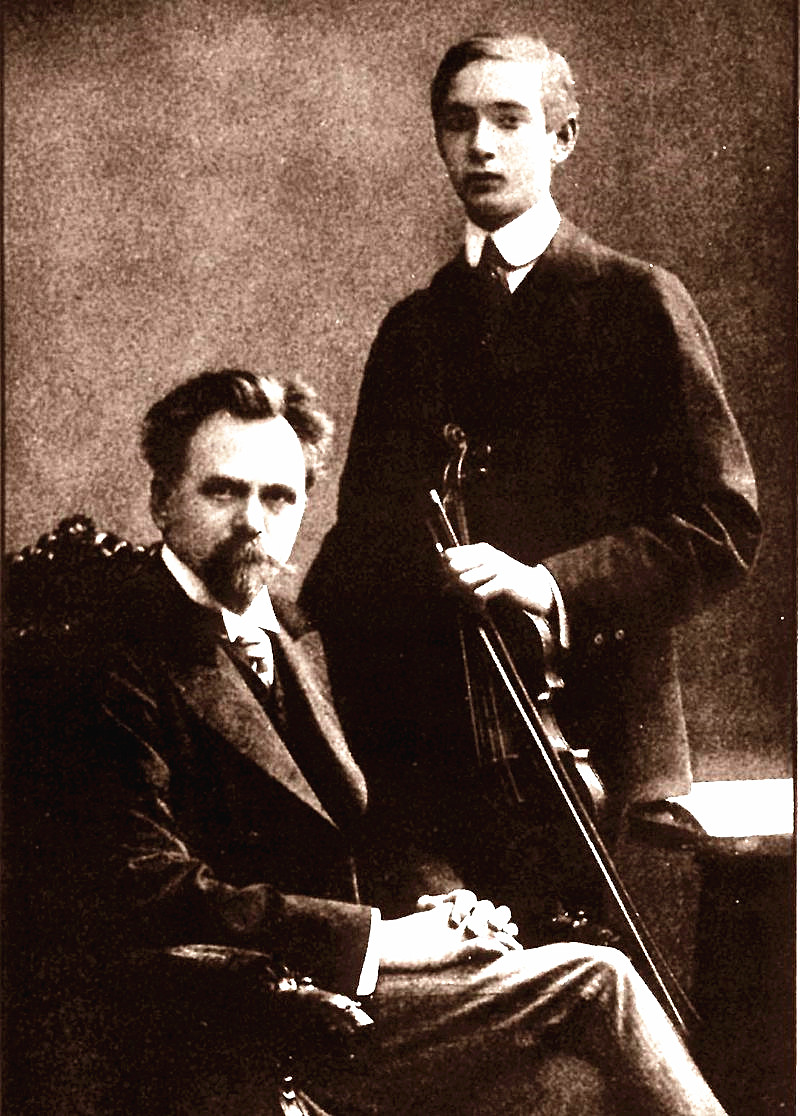 |
|
|
|
| |
西盖蒂和他的老师胡胡拜(左),约 1910
年 |
|
|
|
| |
Hubay (left) and
Szigeti, c. 1910 |
|
|
|
| |
Singing
on the Violin -- Recall The west Getty -- Zheng Yanyi |
|
|
|
| |
Never-before-uploaded 1928 archival audio recording of luminary
Hungarian violin virtuoso Joseph Szigeti performing Brahms
Violin Concerto in D Major.
The Art of Joseph Szigeti
Among the great violinists of the 20th century, Chrysler was
known as the "king of the violin", Heifetz as the dominant
violinist, and Szigeti as the odd violinist.On his Birthday in
1943, Menuhin congratulated him on BBC radio. Isaac Stern from
New York, Oistlage from Moscow, And Milshtan from Montreux,
Switzerland, were on the phone playing "Happy Birthday" to
him.Post to write to him from Moscow, filed in 1937 for his play
the Mendelssohn concerto, letter calls him honorable Master
(Honored Master), describes the youth division post how to think
along your footprint (follow your footsteps, but had to give up
the unrealistic desire (had to abandon this desire in the end,
because to achieve that goal is impossible (it was too about);In
the history of violin, with the exception of Issa, Chrysler and
Heifetz, perhaps no fourth violin has been so universally
respected by his peers.But many of today's music fans may not
know the master, and the two albums now released are just in
time, the most valuable violin documents not to be missed.
First of all, say hello to the fans. If you haven't heard of
Him, you should listen to this CD more often, because chances
are you won't like it at first, you won't be able to listen to
him, and you won't understand what he's all about, just like I
did.But I can assure you that after a few more, it will chew
like an olive and taste lusciously, and there will be no other
violinist like it.On the whole, only Oistlach is anything like
it.Seghetti is more "dry" than Oistlach, but more interesting
when heard, like old Yu Shuyan in Beijing Opera. |
|
|
|
| |
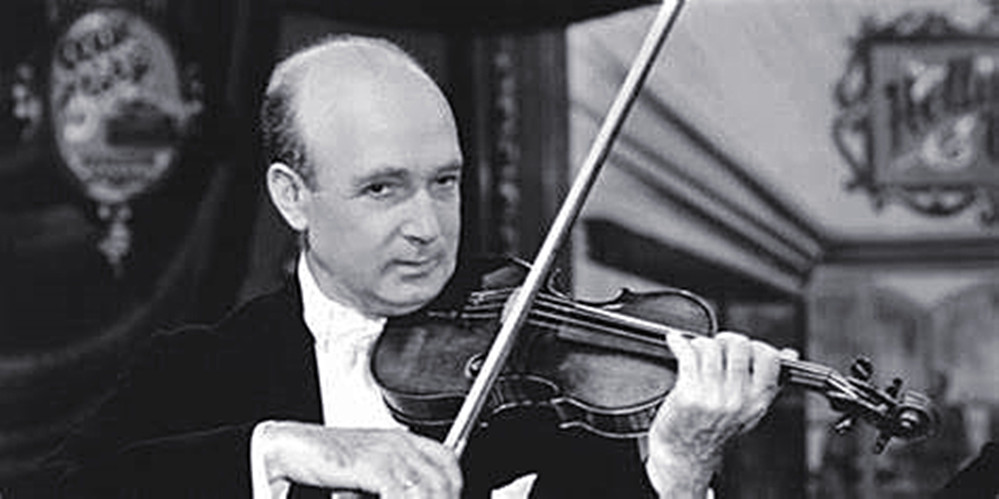 |
|
| |
约瑟夫·西盖蒂(Joseph Szigeti) |
|
|
|
| |
多年前,当我第一次听西盖蒂唱片时,心里觉得奇怪:发音是干的,揉音慢得不象话,跳弓都是毛的,拉什么听起来都吃力;这样一位提琴家有什么了不起?似乎徒有虚名!(本套CD的小品录自1926年至1929年间,是西盖蒂全盛时期,当时发音还酸郁浓厚没那么干,揉音也较快,到1933年录巴赫时发音就干了些,揉音慢了些,到1950年就更干更慢了)。接着在电影纪录片中看到他拉舒伯特的小《蜜蜂》,这么简单的一首小曲子,我也会拉,他出来时头发梳得光光的,演奏时却把头颈都快扭断了,拉完时满头大汗
,头发乱七八糟,实在不知道他好在哪里!可是逐渐听多了就愈来愈觉得他的演绎有一股任何人所没有的醇酸韵味,愈听愈喜欢;才开始理解为什么连梅纽因和奥依斯特拉赫这样以韵味著称的大师都对他推崇备至。可能西盖蒂最大的特点是,讲硬技巧,他的确是诸位大师中最差的;但在音乐演绎上却独树一帜,别具一格。弗莱什曾说过:可惜西盖蒂没跟他学,如果他的弓法和揉音能改进一些,那西盖蒂就会更了不起!这句话我个人认为并不夸张,也不是弗莱什自高自大;从记录片上看西盖蒂拉琴,由于他的手臂手指特长,方法很不自然,看起来鸡手鸭脚,完全是用传统方法硬拉的。克雷默的手也特别长大,可是运用得法;结果就技巧卓绝;但说明问题的却是发音西盖蒂比克雷默好,这就是音乐修养和天分问题。发音好坏,最后决定于演奏者的音乐听觉和概念,方法仅仅是工具。
西盖蒂的成就和弱点和他的时代有关。他是胡鲍伊(Hubay)的学生,受的是传统训练方法和教养(胡
鲍伊是一位修养极高的老师),可是在他13岁的初次登台后他听到了克莱斯勒演奏同一首他在音乐会的维奥蒂第22协奏曲,使他听到了从所未闻的琴声和演绎风格。用西盖蒂自己的话说,克莱斯勒打开了他的眼(耳)界,使他进人了一个新的音乐世界(直到西盖蒂名扬世界后,他还在纽约到处搜罗克莱斯勒的旧唱片,视若珍宝),接着他又听到了伊萨依、蒂博、
艾尔曼。西盖蒂说这
4个人引进了一个提琴演奏风格的新纪元。可是在当时,西盖蒂传统技术的基础已定了型,传统演绎的古典风格也有了根底,由于理智上他清楚,并接受了新演奏风格,及新作家如巴托克、普罗科菲耶夫的新的潮流,西盖蒂就吸收兼蓄两家之长,形成了他自己的特殊风格,朴素的古典严肃却同时又具有内在的醇薄浪漫热情,结果就是这样一位独特的浪漫古典大师。
由于上述的原因,从技术上说,他用的是小布什和胡伯曼,以及梅纽因年青时强迫拉琴的传统方法,这种方法强迫弓子去拉动弦,发出来的音似乎是硬把声音从琴的肚子里拉出来的;泛音少,因此不亮;但却极浓而深厚,特别是G线;似乎是瓮底里传出来的;至于揉音,当时约阿希姆是不赞成的,胡包伊很可能就没教过西盖蒂揉音,更可能是他听了克莱斯勒后自己学的(因为西盖蒂对克莱斯勒是五体投地的佩服;同时这里又可以看到克莱斯勒的了不起,他年龄要比西盖蒂大17岁,所用的演奏方法却是新的、自创的,因为他弓子的发音和揉音都是从所未有,不可能是马萨尔教他的,而且在12岁后,他就没跟过老师,因此他的揉音就运用不得法,速度就慢(很可能是按弦太过用力所导致)。这些,就形成了他在演绎上的技术局限性,但西盖蒂却能在这个局限内,从音乐出发,以他独特的发音、音准的巧妙运用和杰出的节奏处理,通过深人地分析、体会各种不同音乐的风格,
在他的琴上使它们体现了出来;这里要特别指出他的几乎是无痕迹的换弓,这使他拉慢的旋律线如天马行空,长短、逗点、句段都可以随心所欲地表现出来,这点,除外,很少人能做到他的水平(不过由于他跳弓是往下敲出来的,开弓有时也有这种倾向,快分弓有时就不能完全做到毫无痕迹,不及以上几位)。例如巴赫g小调无伴奏的第一乐章的演绎,
他的旋律线处理犹如在叙述,句逗极其细腻,和声和低声部似画龙点睛,清清楚楚地点了出来;节奏上的Rubato和力度变化极其微妙地使句逗、段落更为分明;音准使和声调性鲜明;它是众多版本中最精彩的,是既古典严肃,又抒情富有生命力的维拉契尼和巴赫。还有,可能有很多乐迷不知道,小提琴在拉双音时,弓子在两根弦上的用力不应该是平均的,而应该也可以根据旋律线或低声部分别加以强调;只不过能做到的人不多,听的人只知道效果好坏,却不知道其所以然。
|
|
|
|
| |
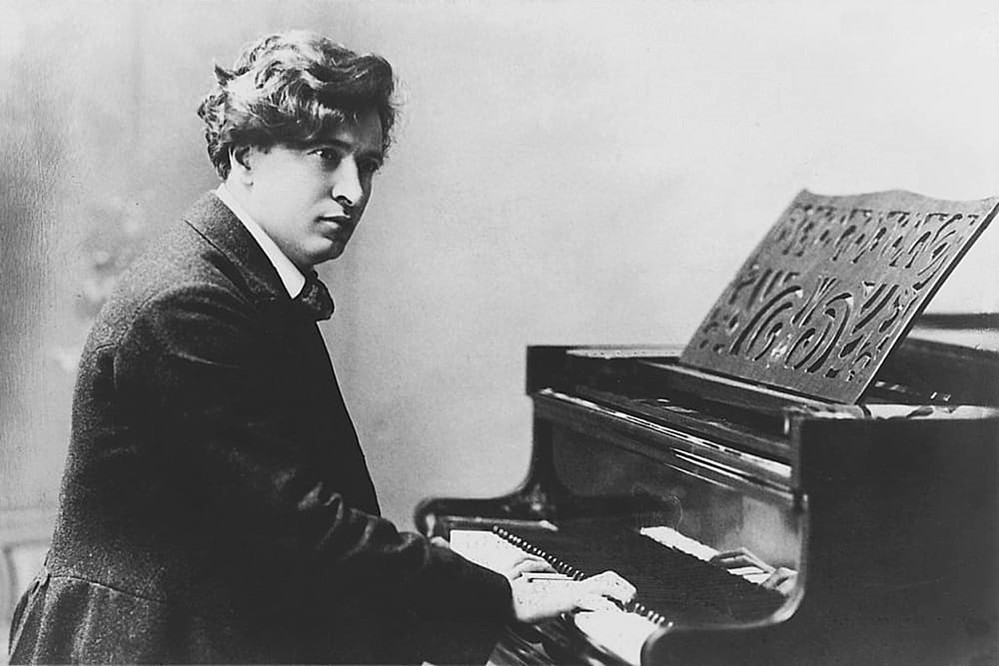 |
|
|
|
| |
约瑟夫·西盖蒂的导师,费鲁奇奥·布索尼 |
|
|
|
| |
Szigeti’s mentor,
Ferruccio Busoni |
|
|
|
| |
Years ago,
when I first listened to A Sigattie record, I found it strange
that the sounds were dry, the notes were painfully slow, the
bows were hairy, and the sounds were labored.What was so great
about such a violinist?It seems to be in vain!(The sketches on
this CD were recorded from 1926 to 1929, the heyday of The
Sigatti, when the pronunciation was still sour and thick and not
so dry and the knead was faster. By 1933, when Bach was
recorded, the pronunciation was dry and the knead was slower,
and by 1950 it was even drier and slower.)Then in the film
documentary saw him play Schubert's little "bee", such a simple
little song, I will also play, he came out of the hair combed
bare, playing but the head and neck are almost broken, when the
end of the sweat, hair at a mess, really do not know where he is
good!However, as I listened more and more, I felt more and more
that his interpretation had an alkyd charm that no one had. The
more I listened, the more I liked it.He began to understand why
even menuhin and Oisterach, masters of charm, admired him so
much.Perhaps the greatest characteristic of Seghetti was that he
was really the worst of the masters in terms of hard skills;But
in the musical interpretation is unique, unique.It's a pity,
Fleish once said, that Segetty didn't learn from him. If his
bowing and rubbing could have improved, He would have been even
better!Personally, I don't think this is an exaggeration, nor is
It that Fleish is conceited;As seen in the documentary, the
Sigheteh is played in an unnatural way due to his long arms and
fingers. It looks like a chicken hand and duck foot, which is
completely pulled by the traditional method.Kramer's hand, too,
was particularly large, but it worked;The result is excellent
skill;But it's the pronunciation that matters. Well, that's the
question of musical accomplishment and talent.Pronunciation is
ultimately determined by the player's musical hearing and
concept, and the method is only a tool.
Seghetti's achievements and weaknesses are related to his
time.He was a student of Hubay, trained in traditional methods
and upbringing (Hubay was a highly cultivated teacher), but
after his 13-year-old debut he heard Chrysler play the same
violetti no. 22 concerto that he had performed in the concert,
giving him a sound and a style he had never heard before.In
Sigatti's own words, Chrysler opened his eyes and ears to a new
world of music (he would scour New York City for old Chrysler
records and treasure them until Sigatti became famous), and then
he heard Isay, Tibbo, Ehrman.Seghetti says the four men
introduced a new era in violin playing style.But at the time,
the getty type is decided on the basis of traditional
technology, the traditional interpretation of the classic style
has a root, due to the reason he knew that on and accept the new
style of play, and new writers such as bartok, prokofiev's new
trend, west getty absorption and accumulation of two long,
formed his own special style, simplicity of classical serious
but has intrinsic alcohol thin romantic passion again at the
same time, the result is such a unique romantic classical
master.
For this reason, technically he used the traditional method of
forcing the strings, as used by George W. Bush and Huberman, and
by Menuhin as a young man, in which the bow is forced to pull
the string, producing sounds that seem to be forced out of the
belly of the instrument;Few overtones, therefore not bright;But
very thick and deep, especially the G line;It seemed to come
from the bottom of a urn;As for kneading, Joachim disapproved at
the time, and Hupaoyi probably never taught Him to knead. It is
more likely that he learned it himself after listening to
Chrysler (because Sigatty was so impressed with Chrysler;Here
and can see Chrysler's fantastic, at the same time he age 17
years older than the west getty, playing method is used in the
new and original, because the pronunciation of his bow and knead
the sound came from is unprecedented, it can't be taught him
mazar, and after the age of 12, he didn't follow the teacher /
-s, so he is using it cannot be rubbing the sound, the speed is
slow (probably) caused by too heavy.These are the technical
limitations of his interpretation, but In this limitation,
Sigatti was able to start from the music, with his unique
pronunciation, intonation and excellent rhythm processing,
through deep analysis and experience of different musical
styles, to make them reflected in his piano;It must be noted he
is almost no trace of the bow change, which made him slow melody
line as a powerful and unconstrained style, length, comma,
sentence, paragraph can follow one's inclinationsly, that,
besides / -s, few people can do his level, but because of his
jump bow is knocked down, drew his sometimes have this tendency,
fast bow sometimes just can't do it without a trace, as more
than a few).For example, the interpretation of Bach's
unaccompanied first movement in G minor, his melody line
processing seems to be narrating, the sentences are extremely
delicate, the harmonies and whispers seem to make the finishing
point, and come out clearly.The Rubato in rhythm and the change
of strength make the sentences and paragraphs more distinct in a
very subtle way;Intonation makes harmonic tonality distinct;It
is the most wonderful of many versions, both classical and
lyrical and full of vitality of Viracini and Bach.What's more,
many music fans may not know that when a violin is playing a
double note, the force of the bow on the two strings should not
be equal, but should also be emphasized separately according to
the melody line or the low voice.It's just that not many people
can do it, and those who listen only know how it works, but
don't know why. |
|
|
|
| |
 |
|
|
|
| |
约瑟夫·西盖蒂(Joseph Szigeti) |
|
|
|
| |
西盖蒂在这方面的功力是罕见的惊人。他不但在拉双音时能随意强调其中的一个音,甚至在和弦中都能强调所需要的某一个音,这是弓子上的真功夫。我曾经说帕尔曼的几首赋格很不错,但西盖蒂比他更高一筹。赋格听起来很容易枯躁,因为复调和弦发音难、容易毛、带噪音,声部线条不易清楚,但在西盖蒂手里,赋格很容易听,旋律声部向逗、段落都清清楚楚,而且发音依然浓酸;这就使他在1931年和1933年所灌的g小调和a小调两首成为巴赫无伴奏公认的典范。听他a小调的行板,就完全像两把提琴在拉,一把在拉旋律
,另一把在伴奏,妙的是两个声部还各有节奏上的Rubato和音准的变化,使之互相衬托;再去听听帕尔曼,优劣立现。值得一提的是有人批评海菲茨拉巴赫用跳弓,其实西盖蒂早就用了,“a小调的快板”就是一个例子。用跳弓是为了有对比,有活跃的生命力,用得恰当无可厚非;只不过西盖蒂的跳弓是传统式用弓敲击出来的,这种跳弓优点在可用弓的任何部位演奏,缺点是杂音较多,力度变化较小(胡伯曼用这种跳弓演奏柴科夫斯基是了不起的技术),西盖蒂在这里用跳弓说明他不是学究派,但的确丰富了这章快板。
西盖蒂不仅在巴赫上是公认的经典,他的近代作品的演绎也同样地有权威性。最突出的是他的巴托克和普罗科菲耶夫。巴托克是他的好朋友,这两张没有这两位作家的曲子,相信第二集一定会有,巴托克不但在写作时征求他的意见,而且还为他弹钢琴伴奏灌唱片(他们的《克莱策奏鸣曲》版本是一个里程碑,仅从这里就可以看到,巴托克还是一位出色的钢琴独奏家和古典乐演绎者)。巴托克和普罗科菲耶夫的小提琴作品能得到普遍地承认,西盖蒂是元老功臣。除这两位外,西盖蒂还首演了许多近代作家的作品。这里有布洛赫,米约的4首小品都极其精彩,尤其是布洛赫和□□□(此处明显错漏),它与年青梅纽因的版本是我所听到过最动人的演绎。使我最惊讶的却是西盖蒂的克莱斯勒作品;而且居然有5首之多。他和克莱斯勒可以说是两个完全不同世界的演奏家,但除克莱斯勒本人外,西盖蒂的演绎是最精彩动人的,包括两首德沃夏克的《斯拉夫舞曲》《西西里舞曲和里戈东舞曲》《爱的忧伤》和《中国花鼓》。我反复地听(从前没听过),才发现是由于西盖蒂抓住了克莱斯勒节奏上和音准的处理变化的结果。由此可见,技术不过是工具(因为西盖蒂的发音、揉音、运弓和克莱斯勒完全不同),音乐的修养才是决定性的因素;而且西盖蒂并不是摹仿,而是有他自己的创造性。
摘自郑延益的音乐评论集《春风风人》 |
|
|
|
| |
郑延益小传 |
|
|
|
| |
郑延益 (1923年5月2日—2011年7月28日)是中国著名弦乐教育家、音乐评论家,祖籍宁波慈溪 ,出生于新加坡。他在上海音乐学院任教期间,创立了中国第一个女子四重奏组 ,并成为中提琴教育的奠基人,培养了 俞丽拿 、 丁芷诺 、 沈榕等一批优秀提琴人才。
早年经历
郑延益六岁开始学习小提琴,十一岁便在新加坡演奏门德尔松 的《E小调小提琴协奏曲》。抗战期间,他辗转香港、上海、重庆等地,曾加入重庆中华交响乐团担任副首席。1948年再次赴新加坡,后于1954年应谭抒真 之邀
回国,进入上海音乐学院 任教。
教育贡献
他在上海音乐学院创立中提琴专业,打破此前由小提琴教师兼授的局面,并开发了一套独特的中提琴教学体系。他强调音准、发音等软技巧的重要性,要求学生通过拉空弦等训练掌握乐器特性。其教学方法为上音中提琴专业后续发展奠定了基础。
艺术活动
郑延益曾参与多个室内乐演出团体,包括1946年加入的“ 中国交响乐团 ”,以及1960年组建的上海女子四重奏组(成员包括俞丽拿、丁芷诺等)。他长期撰写乐评文章,被誉为“ 亚洲乐评人 ”,其著作《春风风人》对音乐普及有重要推动作用。
2011年7月28日,郑延益在香港逝世,享年88岁。 |
|
|
|
| |
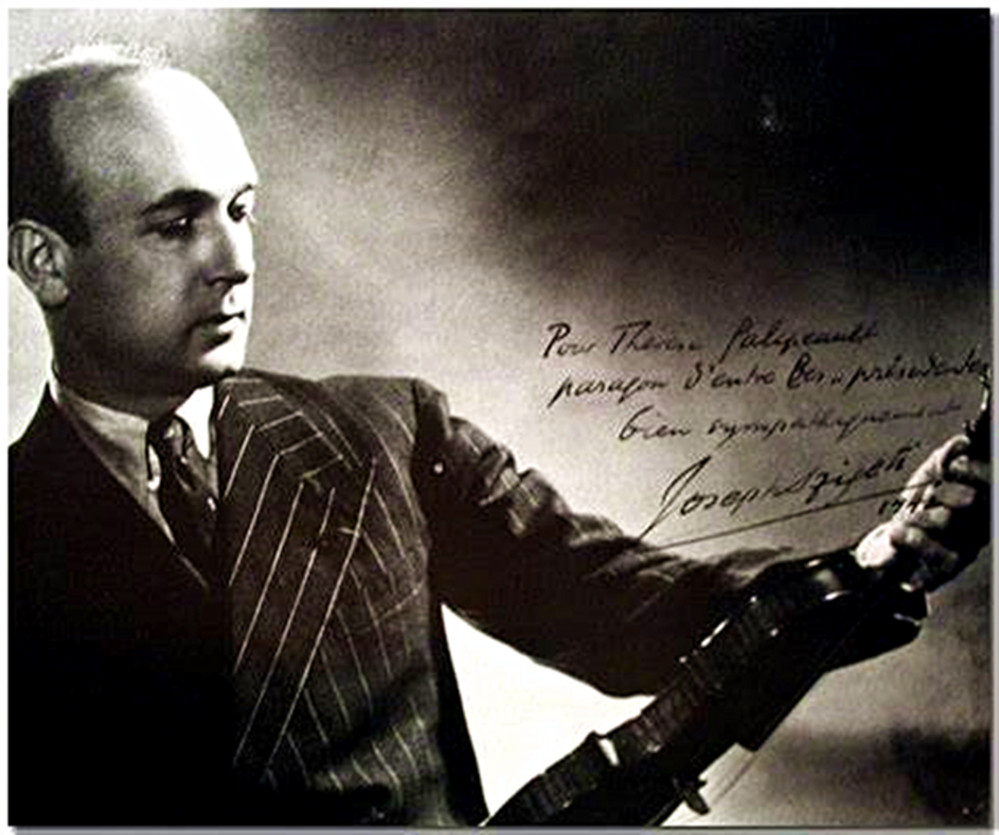 |
|
| |
约瑟夫·西盖蒂(Joseph Szigeti) |
|
|
|
| |
|
|
|
|
| |
Seghetti's
skills in this area are rare and amazing.He was able to
emphasize not only one note in a double note, but also a
particular note in a chord. This was the skill of the bow.I had
said perlman had a few good fugues, but Segetty was a cut above
him.The fugue was easy to hear, because polyphonic chords were
difficult to pronounce, fuzzy and noisy, and the lines were not
clear. But in Sigatty's hands the fugue was easy to hear, the
melody was clear, the paragraphs were clear, and the
pronunciation was still sour.This made his songs in G minor and
A Minor, both in 1931 and 1933, widely regarded as examples of
Bach unaccompanied.To listen to his Andante in A minor is
exactly like playing two violins, one in melody and the other in
accompaniment. The wonderful thing is that the two parts also
have Rubato and intonation changes in rhythm, so that they
complement each other.Listen to Perlman again. The pros and
cons.It's worth noting that Heifezlabach was criticized for
using a jump bow, as Was Segetti, for example, with "Allegro in
A Minor."The purpose of jumping bow is to have contrast, to have
active vitality, and to be properly used.Just west of the getty
jump is a traditional bow knock out with a bow, the jump
advantage in any part of the available bow bow to play, the
disadvantage is that noise is more, efforts to change smaller
(huberman, using this jump bow playing Tchaikovsky is great
technology), west getty here with jump bow shows that he is not
a pedant, but indeed enriched the allegro chapter.
Not only is Sigatti a recognized classic in Bach, but his
interpretation of modern works is equally authoritative.The most
prominent are his Bartok and Prokofiev.Bartok is his good
friend, the two have no melody, the two writers believe that
there will be the second set, bartok not only asking his opinion
in writing, but also for him to play the piano accompaniment
disc (their sonata "clay version is a milestone, only you can
see from here, bartok is an excellent piano soloist and
classical competence).The violin works of Bartok and Prokofiev
are generally recognized, and Sighetti is the patriarch of the
work.In addition to these two, Seghetti premiered the works of
many modern writers.Here is Bloch. Milo's four sketches are
excellent, especially Bloch and □□ (obviously wrong here). It
and the young Menuhin's version are the most moving I have ever
heard.What surprised me most was the Chrysler works of The
Sigattie;And there were five songs.He and Chrysler can be said
to be two completely different worlds of the players, but
besides Chrysler himself, sighetti's performances are the most
fascinating and moving, including two dvorak's "Slavic dance",
"Sicilian and rigdon", "sadness of love" and "China flower
drum".I listened to it over and over (and never heard it before)
and realized that It was Sigatti who had caught up with
Chrysler's changes in rhythm and pitch.Technology, then, is
nothing but a tool (because Sigatee's pronunciation, kneading,
bowing, and Chryslers are so different), and cultivation of
music is the decisive factor;And Sigatti was not an imitation,
but a creation of his own. |
|
|
|
| |
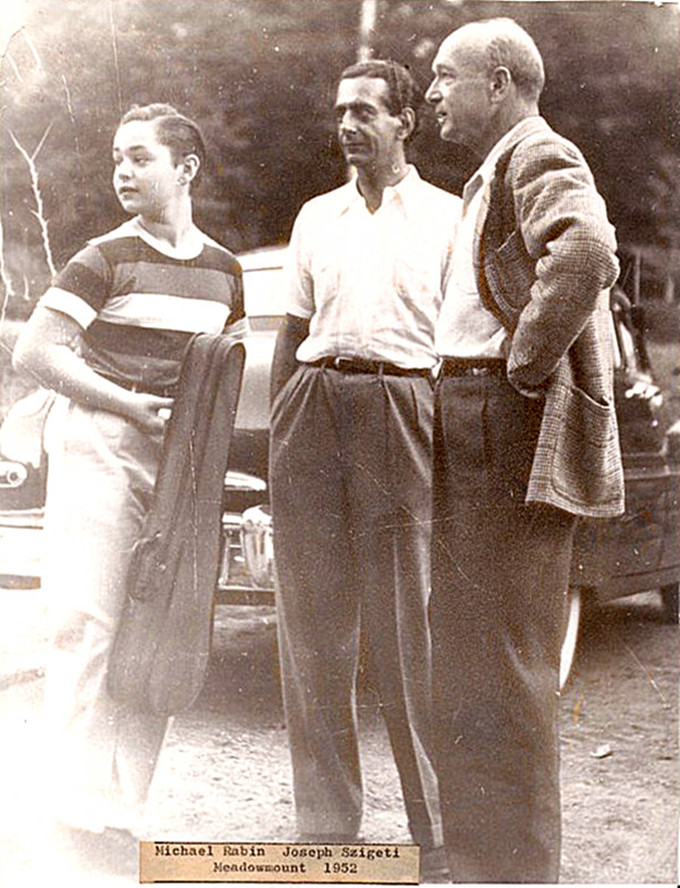 |
|
| |
约瑟夫·西盖蒂(Joseph Szigeti)和加拉米安及拉宾在一起。 |
|
|
|
| |
Joseph Szigeti was
with Garamian and Rabin. |
|
|
|
| |
 |
|
| |
爱丁堡艺术节
图片来源:Gerti Deutsch/Picture Post/Getty Images
1947年9月20日,小提琴家约瑟夫·西盖蒂,中提琴家威廉·普里姆罗斯,钢琴家阿图尔·施纳贝尔和大提琴家皮埃尔·福尼尔(从左至右)在第一届爱丁堡音乐节上。 |
|
|
|
| |
Festival d'Édimbourg
|
|
|
|
| |
西盖蒂与神一样的莫扎特 |
|
|
|
| |
Sigeti and Mozart |
|
|
|
| |
西盖蒂录制的唱片很少,所以他的音频和视频尤其珍贵,特别是他演绎的莫扎特。莫扎特来到这个世界短短的35年,他完成了神交给他的工作之后呢,他就走了,所以我个人认为,能够把莫扎特的作品演绎的好,演绎得非常传神,很好的传达神的语言的演奏家是寥寥无几的,那神的语言呢?对于我们人类这个层次的生物呢?他是不太可能了解的非常透彻的。他不可能一下子就听的很明白的,它可能带一点点迷待一点点惘,用你一生的思考、迷惑,探索、追寻去理解它的意思。
所以说,我很喜欢一位老先生叫辛丰年,我喜欢他写的《乐迷闲话》和《音乐笔记》。其中讲到他听了一辈子的古典音乐最后终于把莫扎特听进去了,那我听了这段话之后呢,我也深有感触,因为我也一样,以前我也不
太喜欢听莫扎特的,听到现在终于能听一点点进去,很有可能就是我刚刚讲的原因,你听的时间太短、你听的太少,听的演奏家、版本太少,你可能没有真正听到过能够把莫扎特演绎得出神入化、或者很好的传达神的那个演奏家,直到听了这个西盖蒂,就真的非常喜欢他了,这就是我刚才所描述的感觉,他有他的特点,他演奏的莫扎特带一点点迷惘,带一点怅然的感觉,就好些一个人,他隔着一层玻璃窗看这个世界。带一点怅然若失的感觉,看外面的世界:斜阳草树,寻常巷陌,小桥流水,牧童短笛。他看这个世界,他不是说我置身在里面,那就太过清澈透亮了,他是隔着一层玻璃看的(用我的话是不是他把自己置身世外,从旁观者的角度去看这个世界——莫扎特之旅)
所以这一点是非常非常难得的,就像我刚才讲的,就是人不可能一下子完全领会理解对神的语言,那么透彻的,他可能带着一点点惘,要经过他的一生不断的去追寻
,方能慢慢的领略到其中的真谛。
(上面是古典音乐发烧友猴脑丝讲故事视频的资料——莫扎特之旅整理) |
|
|
|
| |
Sigeti recorded
very few albums, so his audio and video works are particularly precious,
especially his interpretations of Mozart. Mozart was in this world for
only 35 years. After completing the task assigned to him by God, he
left. Therefore, in my personal opinion, there are very few musicians
who can perform Mozart's works well, vividly and well convey the
language of God. So, what about the language of God? What about
creatures at the level of human beings? It's unlikely that he will
understand it very thoroughly. It's impossible for him to understand it
very clearly at once. It might carry a bit of confusion and
bewilderment. You need to spend your entire life thinking, perplexing,
exploring and pursuing to comprehend its meaning.
So, I really like an old gentleman named Xin Fengnian. I like the books
he wrote, "Casual Chats with Music Fans" and "Music Notes". It was
mentioned that after listening to classical music all his life, he
finally got to listen to Mozart. After hearing this, I was also deeply
touched. Because I was the same. Before, I didn't like listening to
Mozart very much either. But now I can finally get a little into it.
It's very likely the reason I just mentioned: you listen for too short a
time and too little. There are too few musicians and versions you have
listened to. You may not have truly heard a musician who can interpret
Mozart with such perfection or convey the divine essence very well. But
after listening to this Sigetti, you will really like him. This is the
feeling I just described. He has his own characteristics. The Mozart he
plays has a touch of confusion and a hint of melancholy. It's just like
a person. He looked at the world through a glass window. With a touch of
melancholy and loss, I look at the outside world: slanting sun, grass
and trees, ordinary alleys and lanes, small Bridges and flowing water,
shepherd boys and short flutes. He looks at the world. He doesn't say
that if I were inside it, it would be too clear and bright. He looks
through a layer of glass (in my words, is it that he places himself
outside the world and views the world from an outsider's perspective -
Mozart's Journey)
So this point is extremely rare. Just as I mentioned earlier, it is
impossible for a person to fully understand the language of God at once,
so thoroughly. He may be a little confused and has to constantly pursue
it throughout his life before he can gradually appreciate its true
meaning.
(The above is the material of the storytelling video by the classical
music enthusiast Monkey Brain Si - compiled by Mozart's Journey) |
|
|
|
| |
 |
|
|
|
| |
约瑟夫·西盖蒂(Joseph Szigeti)——匈牙利小提琴演奏家(1892-1973),他也是新音乐的强烈倡导者。漂亮的黑白照片,他签名并题字,用法语写了很长一段感情,日期是1954年,在排练中展示。这张照片是由布宜诺斯艾利斯的摄影师卡门用墨水印在背面的。尺寸为4.7
x 6.9英寸,右上角的折痕不影响图像,否则状况极佳。
|
|
|
|
| |
Joseph Szigeti——Hungarian virtuoso
violinist (1892-1973), who also distinguished himself as a strong
advocate of new music. Beautiful black-and-white photograph signed and
inscribed by him with a long sentiment in French, dated in 1954, shown
in rehearsal. Photo is ink-stamped on verso by photographer Carmen,
Buenos Aires. Size is 4.7 x 6.9 inches, crease over the upper-right
corner not affecting image, otherwise in excellent condition. |
|
|
|
| |
|
|
|
|
| |
Today in Music
History
On September 5, 1892, Joseph Szigeti was born in Budapest, Hungary.
Joseph Szigeti (1892-1973) was born in Budapest, Hungary in 1892. Due to
the fact that both his father and uncle were violinists, he developed an
indissoluble bond with the violin at a young age. Under the personal
guidance of his father and uncle, Szigeti learned to play the violin
very early. Later, in order to enable him to improve his skills quickly
and pursue further studies, his father sent him to the Budapest
Conservatory of Music. Here, Szigeti was fortunate to become a student
of the renowned Hungarian violinist Jenő Huβe. Under the meticulous
guidance of the master, Szigeti's playing skills rapidly improved. At
the age of ten, he had already given his first solo concert at the
conservatory. At that time, people were very surprised by his
outstanding talent and many admired and admired him, calling him a child
prodigy. When he was 12 years old, another great Hungarian violinist,
József Jáschim, met him. This highly respected violin master at that
time immediately saw the talent of the young Szigeti and gave him
lessons for a period of time, enabling this young violinist to learn
many valuable things from the master.
Sigauti began his long career as a performer at the age of 13. In 1905,
he held his first public concert in Berlin, Germany. From 1907 to 1913,
he gave numerous concerts in major cities of the United Kingdom.
Besides, for a considerable period of time, he conducted extensive
touring performances in famous cities across Europe, including Paris,
Brussels, Budapest, Bucharest, Stockholm, Madrid and Amsterdam, etc.
Everywhere he went, he was warmly welcomed by the local audiences, and
people from all walks of life, including the critics, highly praised his
wonderful performances. Since then, he became a renowned violinist
renowned throughout Europe. Due to the high artistic honors and prestige
he had achieved at that time, in 1917, the famous Geneva Music Academy
in Switzerland hired him to replace Henry Martor and serve as the violin
professor of the academy. Sigauti worked successfully at this position
until 1924. This experience later became a very meaningful milestone in
Sigauti's entire artistic career.
While serving as a violin professor at the Geneva Conservatory,
Cecchetti never ceased his arduous performance activities, and their
scope and influence continued to expand. In 1925, he was invited by the
renowned conductor Stokowski to set foot on American soil for the first
time. He held solo concerts in Philadelphia and New York, performing
Beethoven's "D Major Violin Concerto", and was highly praised by the
local audience. At that time, the music critics in the United States
praised him in their articles, referring to him as "the musician among
musicians" and "the smart and intelligent violinist". This sensational
effect enabled Cecchetti to gain an authoritative reputation in the
United States and also gave his future career in the United States a
good start. By 1951, Cecchetti had become an American citizen. In 1960,
at the age of 68, Cecchetti settled in Switzerland. From this time on,
he shifted the main direction of his work to writing and serving as an
international competition judge. Cecchetti left behind many works on
violin art throughout his life, the most famous of which include "Notes
of a Violinist", "Loves of Strings", and "Cecchetti on Violin", etc. As
for the judging work, it was even busier. As early as 1937, he had
served as the chief judge of the International Isay Violin Competition.
It was in that competition that the later violin virtuoso Oistrakh, with
his unparalleled talent, won the championship with a performance that
was unparalleled. Among them, Cecchetti's discerning talent selection
undoubtedly played a very important role. Among violinists, there are
some who are characteristic performers with relatively narrow styles.
These performers play relatively narrow ranges of works and do not have
a comprehensive grasp of styles. The famous Thibaud is a prominent
example. Due to his personality, he had excellent interpretation
abilities for French and German, Austrian early works, but for the
interpretations of many works by composers from other countries, he
seemed to be unable to handle them or even powerless. However, Cecchetti
was different. In this regard, he was a true master with comprehensive
control ability. In terms of the range of works he performed, he was not
only proficient in the interpretation of classical works, but also had
extremely excellent mastery of many strange modernist works. In the
interpretation of classical works, he had very strict control of the
scale, and for many of these works, his interpretation was of the most
authoritative nature. For Bach's works, especially his six unaccompanied
sonatas, Cecchetti's performance made many of his great colleagues feel
admiration. The famous violist Primrose, after listening to Cecchetti's
performance of Bach's unaccompanied sonatas, once exclaimed to someone:
"What is frustrating is that he has 'more strings' and 'more fingers'
than us!"
Sigaditi was not only skilled at performing classical works, but also
had a strong interest and enthusiasm for modernist compositions. During
the early 20th century, when his performing art reached its peak, he
highly praised Prokofiev's violin concerto. In 1925, while he was
successfully performing Beethoven's violin concerto in the United States
and achieving unparalleled success, he came to London, England, and
performed Prokofiev's "D Major First Violin Concerto" for the local
audience. Moreover, he endeavored to support some modern composers to
create new violin works. In his own words, "I hope that new works will
appear in every one of my concerts." When supporting some modern
composers to engage in violin music composition, he often patiently
provided them with technical assistance and advice on experience. To
express gratitude and repay the help and contributions he brought, many
composers presented their new works to him and requested that he give
the premier performance. These works included Bartók's "First Violin
Rhapsody", Boukhovetsky's "Night in a Foreign Land", Prokofiev's
"Melody" and "D Major Violin Sonata", Martyn's "Violin Concerto",
Harti's "D Minor Violin Concerto", Casella's "A Minor Violin Concerto"
and Kowal's "Violin Sonata", etc. The new works mentioned above were all
premiered by Sigaditi. Sigaditi was not only an outstanding violinist
but also an excellent violin educator. In his early years, he served as
a violin professor at the Geneva Music Academy in Switzerland for seven
years, cultivating many outstanding violinists. In teaching, Sigaditi
always warned his students not to merely show off dazzling techniques
but to apply the techniques to expressing music. He always emphasized:
"When we practice, we should focus on analysis and research, just like
understanding the thoughts of a writer from his words. We should seek
the meaning of the work through the notes." Among the many students he
taught, the Israeli violinist Ronnie Rogoff was the most outstanding. He
began to study under Sigaditi in Montreux, Switzerland, in 1969 and
studied there for many years.
Sigetti undoubtedly was a figure who left an indelible mark in history.
As an artistic luminary of his era, his influence and impact cannot be
expressed through words and language. On February 19, 1973, Sigetti
passed away at the age of 81 in Lucerne, Switzerland.
Today's video: 1.
Joseph Szigeti performs Mozart's G Major Violin Concerto No. 3 K. 216;
2. Szigeti and Bartók perform "Beethoven's Ninth Violin Sonata
'Kreutzer'" ; 3. Szigeti plays Schubert's "The Bee"; 4. Documentary
"Szigeti's Art". |
|
|
|
| |
|
|
|
|
| |
|
|
| |
【西盖蒂x巴托克】贝多芬第九小提琴奏鸣曲“克鲁采” |
|
|
|
| |
Joseph
Szigeti, Bela Bartok: Beethoven Kreutzer Sonata |
|
|
|
| |
|
|
|
|
| |
约瑟夫·
西盖蒂演奏舒伯特的《蜜蜂》 |
|
|
|
| |
the Bee
by François Schubert(1808-1878) |
|
|
|
| |
|
|
|
|
| |
|
|
|
|
| |
伟大的小提琴家约瑟夫·西盖蒂(Joseph
Szigeti)
|
|
|
|
| |
The 19 Greatest Sketches of all time by Ivry Gitlis |
|
|
|
| |
|
|
|
|
| |
未得原作者编者授权严禁转载www.mt77.com任何内容 |
|
|
|
|
|
|
|
|
|
|
|
|
|
|


